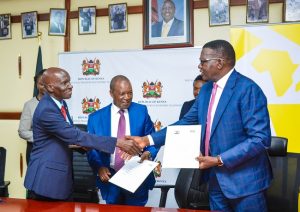The Government of Kenya and ATIDI, the African Trade Insurance Agency, have signed the Regional Liquidity Support Facility Memorandum of Understanding to collaborate in identifying, developing, and implementing renewable energy projects across Kenya.

RLSF, a joint initiative of ATIDI, the KfW Development Bank and the Norwegian Agency for Development Cooperation (Norad), is a credit enhancement instrument provided by ATIDI to renewable energy Independent Power Producers (IPPs) that sell the electricity generated by their projects to state-owned power utilities. The instrument’s scope has recently been extended to provide support for eligible transmission projects, allowing for possible private sector participation in this key sub-sector.
ATIDI will issue liquidity instruments, or “RLSF policies”, backed by cash collateral from KfW and Norad, to IPPs or private transmission companies for a maximum tenor of up to 15 years; each RLSF policy will cover up to a maximum of 12 months’ worth of revenue for the project. The RLSF cover is available to renewable energy projects of up to 100 MW (larger projects can be considered on a case-by-case basis), and private financed transmission projects. With the RLSF MoU now in place, ATIDI will engage with IPPs in Kenya with the expectation that advanced hydro, geothermal, solar, and wind projects may benefit from this instrument in the near future.
The projects will not only focus on leveraging the country’s abundant natural resources to generate clean and sustainable energy but will also reinforce its power generation and transmission capacity.
Statistics show that over 80% of Kenya’s electricity is generated from renewable energy sources. This places the country of over 50 million people well on its way to meeting its goal of transitioning to 100 percent clean energy by 2030; signing of the RLSF MoU will provide an additional incentive for private sector participation in achieving this goal as recipients of this liquidity instrument will benefit from ATIDI’s positive credit rating of A and A3 from S&P and Moody’s, respectively.
Parties to the MoU include the National Treasury; the Ministry of Energy & Petroleum, Geothermal Development Company (GDC), Kenya Electricity Transmission Company Limited (KETRACO), and Kenya Power and Lighting Company (KPLC). The RLSF MoU supplements the membership agreements already in place between ATIDI and the Government of Kenya.
Kenya becomes the tenth ATIDI member state to sign the RLSF MoU after Benin, Burundi, Côte d’Ivoire, Ghana, Madagascar, Malawi, Togo, Uganda and Zambia, with the expectation that more of ATIDI’s member states will sign up. To date, RLSF policies have been issued in support of six renewable energy projects in Burundi, Malawi and Uganda; enabling total financing of $207.5 million and a total installed electricity generation capacity of 136.3 MW.
Manuel Moses, CEO, ATIDI, said: “We are pleased to be crossing this key milestone with the Government of Kenya. Not only does this send out a positive message to project developers, lenders, and other prospective stakeholders looking to invest in Kenya’s energy sector, it also reinforces the various ways in which multilateral financial institutions, such as ATIDI, are constantly looking for innovative ways to increase financial flows into African countries. Our support for new projects in Kenya via RLSF will build on our historical involvement in the country’s energy sector, having supported projects such as the Lake Turkana and Kipeto wind projects in the past.”
Prof. Njuguna Ndung’u, Cabinet Secretary, National Treasury, said: “On behalf of the Government of Kenya, the National Treasury is constantly looking for various ways to encourage private sector participation in the financing of key infrastructure, such as the development of renewable energy power plants and key transmission infrastructure. With this MoU with ATIDI, a multilateral institution that we are proud to not only be a founding member of but to host with its headquarters in Nairobi, the provision of RLSF policies will hopefully enable more projects to advance whilst reducing the need for government-backed credit enhancement tools.”
Davis Chirchir, Cabinet Secretary, Ministry of Energy & Petroleum, said: “The planned collaboration between ATIDI and the Government of Kenya particularly through our power utilities, GDC, KETRACO, and KPLC should make a positive contribution towards the attainment of the country’s long term development agenda – the Vision 2030 – which aims to ensure Kenya becomes a ‘newly-industrialising, middle-income economy, providing a high quality of life to all its citizens in a clean and secure environment’ – increased energy access and greater reliability, courtesy of instruments such as RLSF and similar alternatives, is a key enabler of this vision.”
